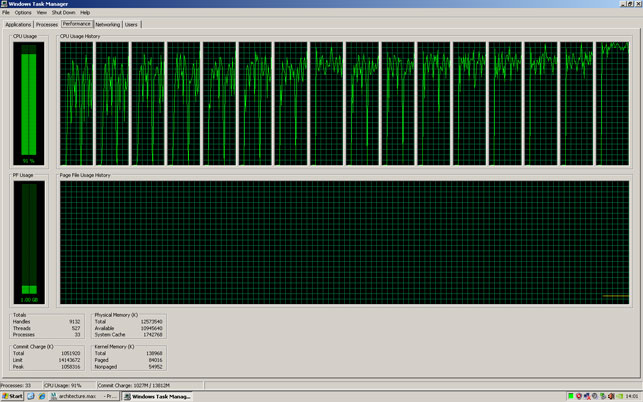Intel’s Core i7 CPU came to market at the tail end of last year, but it’s not until now that the chip giant has launched its ‘official’ workstation platform. The Xeon 5500 series (codenamed Nehalem) forms the backbone to all of the major vendors’ workstations and you won’t see the mainstream Core i7 chip in workstations from the likes of Dell, HP, Fujitsu-Siemens and Lenovo.
On paper, there appears to be little difference between Core i7 and Xeon 5500 Series. They both feature Intel’s Quick Path Interconnection (QPI) (which connects the CPU directly to the memory for faster access), TurboBoost (which enables CPU cores to run at a higher frequency when there is thermal/power headroom) and HyperThreading (which creates a virtual core on top of every physical core). However, Xeon 5500 shows its workstation-class credentials by its availability in dual socket workstations for access to a total of 16 cores and support for ECC (Error Correcting Code) memory for better accuracy.

Count them. One, two, three…. sixteen CPU cores working flat out rendering in 3ds Max Design 2009
The most obvious beneficiaries of new dual socket Xeon 5500 series workstations will be users of multi-threaded design visualisation applications like Autodesk’s 3ds Max and Bunkspeed’s HyperShot, which not only make use of all eight physical cores to drive down rendering times, but also get a little boost from the eight virtual cores delivered through HyperThreading.
For high-end CAM (Computer Aided Manufacturing) and CAE (Computer Aided Engineering) users, having access to eight physical cores is also likely to be a major attraction. While many toolpath calculations and simulations can only be accelerated by two or four cores, it’s the Xeon 5500 Series’ ability to multi-task, (or mega-task, as Intel calls it), that is likely to bring the most interest.
For CAM, users will be able to generate multiple NC toolpaths concurrently, while CAE users can mesh and simulate multiple design variants at the same time.
For pure CAD, dual socket Xeon 5500 Series workstations are likely to be overkill, primarily because most CAD software is single threaded. However, with most CAD applications offering in-built rendering and simulation tools, they shouldn’t be discounted altogether. For users with occasional requirements of such technologies, then four cores in a single socket machine is still plenty.
A single socket variant of the new Xeon chip, the Xeon 3500 Series is also available, and there is also the option of a dual socket machine with a single CPU with a view to upgrading in the future.
By giving designers such power on the desktop, Xeon 5500 has the potential to redefine traditional design, analyse, iterate workflows
First impressions
To put the new Xeon 5500 Series through its paces, Workstation Specialists sent us a prototype of its new high-end workstation, which features two Xeon X5560 (2.80GHz) processors, 12GB DDR3 1333MHz, an Nvidia Quadro FX4800 professional graphics card, and Windows XP x64. (N.B. Workstation Specialists is the new name for CAD2)
We tested with 3ds Max Design 2009, an application that makes full use of multiple CPU cores, and performed our standard scanline rendering benchmark.
While standing head and shoulders above single processor Core i7 workstations we have tested, the render time of 490 secs was a little slower than what we expected, around 10-15% slower. We initially wondered if 3ds Max was actually able to support sixteen CPU cores on a single machine, but Windows Task Manager showed them all working away happily. From our limited first round tests it was hard to form any definitive conclusions, particularly as we were testing with beta hardware, but will certainly look at this more closely in the coming months, along with some multi-tasking scenarios.
For interest, we also dived into the BIOS, turned off HyperThreading and repeated the test. Only eight cores were shown in Windows Task Manager and we recorded scanline render times around 10% slower, confirming there are benefits of using HyperThreading in 3ds Max.
Conclusion
Despite being a bit underwhelmed with the results of the 3ds Max benchmark test, it’s clear that Intel’s new Xeon 5500 Series is a huge step forward for users of highly parallel applications, and those performing so-called ‘mega-tasking’. And by giving designers and engineers access to this amount of power on the desktop it has the potential to redefine traditional design, analyse, iterate workflows.
However, Intel’s Xeon 5500 Series is not for everyone. Having eight physical cores is overkill for most mainstream CAD users, and single socket Xeon 3500 Series workstations or specialist Core i7-based machines are more than capable for most tasks.
In the future though, as design software evolves and makes more intelligent use of CPU cores, this is likely to change. Autodesk, for one, is already talking about using spare CPU cores to give engineers performance-related feedback on design decisions they haven’t yet made.
The intention is that the engineer can increase the number of iterations, but doesn’t have to go through traditional workflow himself, where he designs, analyses and then iterates. He is presented with a number of variations on a theme, each with different geometry configurations which have already been analysed and assessed for purpose, and picks the most appropriate.
While this highly intelligent design technology may still be years off reaching maturity, the foundations have certainly been laid and Intel’s Xeon 5500 and future incarnations of this multi-core technology will be at the heart of making this happen.
{encode=”greg@x3dmedia.com” title=”greg@x3dmedia.com”}
| Product | Xeon 5500 Series |
|---|---|
| Company name | Intel |
| Price | TBC |






